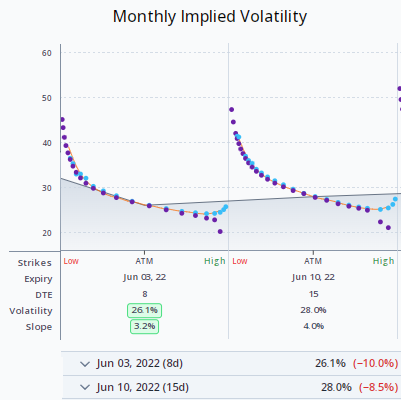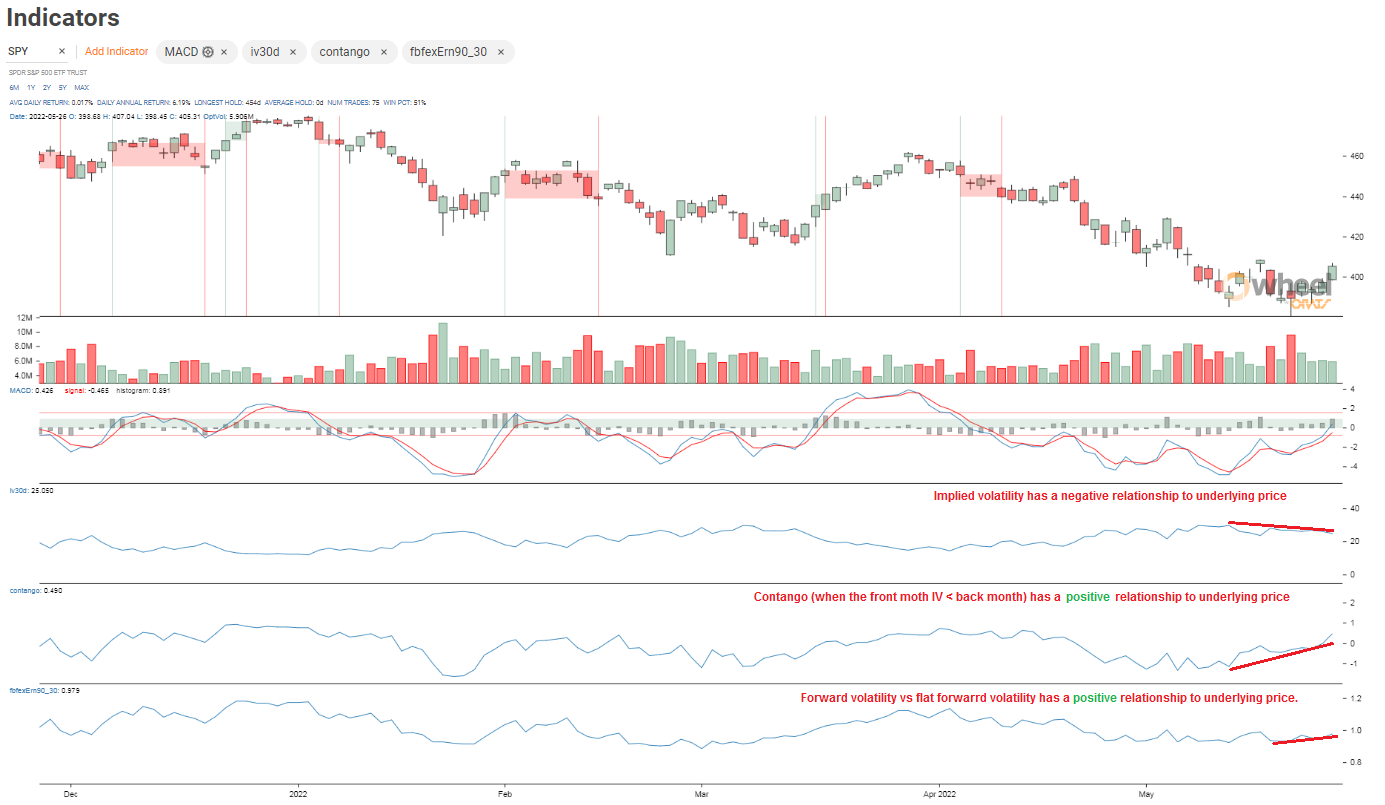Indicators
Thursday, December 20th 2018
Term Structure of Implied Volatility
Term Structure of Implied Volatility
Summary
ORATS summarizes the term structure parameters using the implied volatility at-the-money for each expiration, which can be viewed historically as technical indicators against stock price and implied volatility. The term structure is important to estimate the earnings effect for stocks with earnings announcements upcoming and the parameters of the term structure can be described as the implied volatility at the constant 30-day maturity, IV at the 2-year maturity, earnings move, and slope of the term structure for the first 45 days.
ORATS summarizes the term structure parameters using the implied volatility at-the-money for each expiration. The summarized IV term skew can then be compared to the actual expiration IVs to observe any outlier months and the shape of the term structure can be observed for clues about the up-coming expected movement in the stock.
The term structure parameters can be viewed historically to test as technical indicators against stock price and implied volatility.
The term structure is also important to estimate the earnings effect for stocks with earnings announcements upcoming and how IV might fall after earnings.
The parameters of the term structure can be described as follows: 1) implied volatility at the constant 30-day maturity 2) IV at the 2-year maturity 3) earnings move 4) slope of the term structure for the first 45 days.
Consider CSCO as an example of summarizing the term structure parameters. The goal of the summarization is to have parameters that are comparable over time and to other tickers. To accomplish this, for stocks with earnings the term structure will be summarized by taking out the implied earnings effect.


In CSCO's example above, the 30-day ex-earnings implied volatility is 18.6% and the 2-year IV is 17.2%. The implied earnings move in percentage terms is 5.1% and the slope of the first 45 days of term structure is 0.12%. The earnings effect for each expiration is circled above.
The implied volatility at the constant 30-day maturity reading can be thought of as "the VIX of each stock". In ways this calculation is richer than the VIX that uses options prices of the two expirations around the 30 day. The VIX is rarely close to the true at-the-money implied volatility. ORATS uses many options implied volatility to arrive at a very accurate ATM IV and interpolates with expirations around the 30-day.
Disclaimer:
The opinions and ideas presented herein are for informational and educational purposes only and should not be construed to represent trading or investment advice tailored to your investment objectives. You should not rely solely on any content herein and we strongly encourage you to discuss any trades or investments with your broker or investment adviser, prior to execution. None of the information contained herein constitutes a recommendation that any particular security, portfolio, transaction, or investment strategy is suitable for any specific person. Option trading and investing involves risk and is not suitable for all investors.
All opinions are based upon information and systems considered reliable, but we do not warrant the completeness or accuracy, and such information should not be relied upon as such. We are under no obligation to update or correct any information herein. All statements and opinions are subject to change without notice.
Past performance is not indicative of future results. We do not, will not and cannot guarantee any specific outcome or profit. All traders and investors must be aware of the real risk of loss in following any strategy or investment discussed herein.
Owners, employees, directors, shareholders, officers, agents or representatives of ORATS may have interests or positions in securities of any company profiled herein. Specifically, such individuals or entities may buy or sell positions, and may or may not follow the information provided herein. Some or all of the positions may have been acquired prior to the publication of such information, and such positions may increase or decrease at any time. Any opinions expressed and/or information are statements of judgment as of the date of publication only.
Day trading, short term trading, options trading, and futures trading are extremely risky undertakings. They generally are not appropriate for someone with limited capital, little or no trading experience, and/ or a low tolerance for risk. Never execute a trade unless you can afford to and are prepared to lose your entire investment. In addition, certain trades may result in a loss greater than your entire investment. Always perform your own due diligence and, as appropriate, make informed decisions with the help of a licensed financial professional.
Commissions, fees and other costs associated with investing or trading may vary from broker to broker. All investors and traders are advised to speak with their stock broker or investment adviser about these costs. Be aware that certain trades that may be profitable for some may not be profitable for others, after taking into account these costs. In certain markets, investors and traders may not always be able to buy or sell a position at the price discussed, and consequently not be able to take advantage of certain trades discussed herein.
Be sure to read the OCCs Characteristics and Risks of Standardized Options to learn more about options trading.
Related Posts



